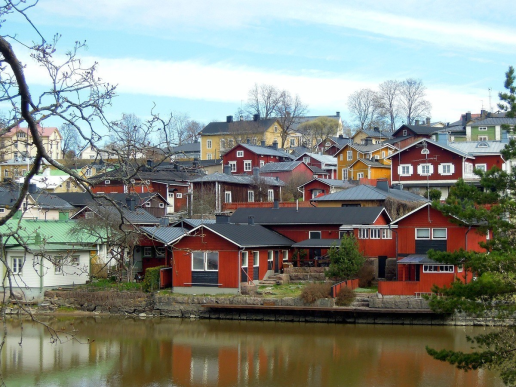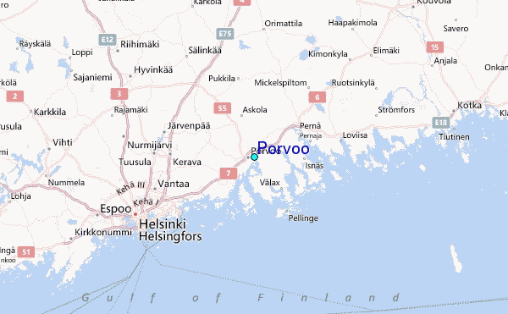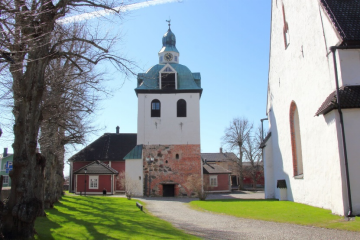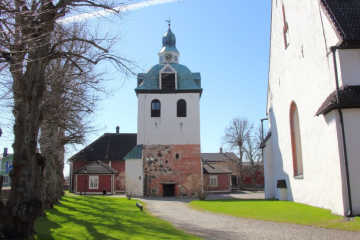Porvoo 作者: 来源: 发布时间:2021-04-20
一、所属省或是州,具体位置,人口,面积
Porvoo is a city and a municipality situated on the southern coast of Finland approximately 50 kilometres (30 mi) east of Helsinki. It is one of the six medieval towns in Finland, first mentioned as a city in texts from the 14th century. Porvoo is the seat of the Swedish-speaking Diocese of Borgå of the Evangelical Lutheran Church of Finland.
The Porvoo Old Town is a popular tourist destination, known for its well-preserved 18th and 19th century buildings and 15th century cathedral, the Porvoo Cathedral. The Old Town together with Porvoonjoki River Valley is recognized as historically and culturally significant as one of the National landscapes of Finland. Porvoo is internationally considered to be one of the most beautiful towns in Finland. The town of Porvoo has about 50 000 inhabitants, of which 51% are female and 49% men. The fact that Porvoo is a bilingual town brings its own twist to the everyday life. The people here speak Finnish and Swedish, sometimes even in the same sentence. About 67% of the inhabitants are Finnish speaking, and about 30% of the inhabitants are speaking Swedish as their mother tongue. 3% of the inhabitants speak some other language.
The municipality's official languages are Finnish and Swedish. In 2014, 64.6% of the population spoke Finnish as their native language, while 30.1% were Swedish speakers. 5.4% had a different native language. Porvoo's neighbouring municipalities are Askola, Loviisa, Myrskylä, Pornainen, and Sipoo.
The town received its name from a Swedish medieval fortress near the river Porvoonjoki, which flows through the town. The name Porvoo is the Fennicised version of the Swedish name (Borgå) and its parts of borg, meaning "castle", and å, "river".

二、自然地理
1.地理条件
Porvoo’s land area is 655 km², water area is 1114 km² and the population density is 70 person/km². The town is divided in the centre area, bigger suburbs such as Kevätkumpu, Huhtinen, Näsi, Peippola and Gammelbacka, smaller urban areas and a wide rural- and archipelago area.
By the end of the 20th century, there was pressure to develop the essentially untouched western side of the river. There was concern that growth would necessitate the construction of a second bridge across the river into the town, thus putting further strain on the aging wooden town. An architectural competition was held in 1990, the winning entry of which proposed building the second bridge. Plans for the western side of the river have progressed under the direction of architect Tuomas Siitonen, and both a vehicle bridge and a pedestrian bridge have been built. The design for new housing is based on a typology derived from the old storehouses on the opposite side of the river. Yet another new development entails the construction of a large business park called King's Gate (Finnish: Kuninkaanportti, Swedish: Kungsporten), which is under construction.
The Porvoo railway station does not have a regular train service, but special museum trains from Kerava (either with steam locomotives or former VR diesel railcars from the 1950s) operate on summer weekends.
2. 交通情况
Porvoo is on the route of the E18 road from Helsinki to St Petersburg. It is currently the largest Finnish municipality without scheduled railway services, since passenger rail services to Porvoo ended in 1981 and freight services in 1990, however proposals exist to link Porvoo to the rail network as part of a new rail line from Helsinki to Kouvola via a tunnel between Pasila and Helsinki Airport.

三、经济发展和规模
Today's Porvoo is a vivid city catering a full range of commercial and public services. The city is a thriving centre for the economic region of the eastern part of the province of Uusimaa.
The Gross domestic product (GDP) of the region Porvoo was 91.2 billion € in 2018, accounting for 38.9% of Finnish economic output. GDP per capita adjusted for purchasing power was 43,500 € or 144% of the EU27 average in the same year. The GDP per employee was 120% of the EU average.
More than half of the citizens of Porvoo gain their livelihood from trade and services, compared to a third who work in the industrial sector.
四、产业特点重点项目
Porvoo originally grew up as a trade centre and it continues to be an attractive focal point as a centre of business and commerce. The volume of retail trade makes Porvoo one of the bigger municipal centres. People from the wide surrounding area come to the town to do their shopping.
The traditions and structure of industry and commercial life are based on two vibrant industrial branches in Porvoo - electrotechnical and petrochemical industries. The Ensto Group has specialized in the electrotechnical field as well as in automation and electronics. The oil refinery ongoing to the national oil company Neste oil and the petrochemical production plant of Borealis Polymers Oy are nowadays part of the modern profile of Porvoo.
五、风景名胜,景点( attractions)
1. Porvoo Cathedral

Porvoo Cathedral is a cathedral of the Evangelical Lutheran Church of Finland in Porvoo, Finland. It was built in the 15th century, although the oldest parts date from the 13th century. It is the seat of the Diocese of Borgå, Finland's Swedish-speaking diocese. The cathedral is also used for services by the Porvoo Finnish-speaking parish, which is administratively part of the Diocese of Helsinki. The church first became a cathedral in 1723, when the diocese of Viipuri moved to Porvoo, after Vyborg was ceded to Russia in the Treaty of Nystad.
2. Pellinki

Pellinki is an island community in Finland made up of several small islands, the main ones linked by bridges. It is located 80 km east of the capital Helsinki, and 30 km south of the town of Porvoo/Borgå. It is administered as part of the municipality of Porvoo/Borgå. Pellinki is accessible from the Finnish mainland via a small vehicle/pedestrian ferry from Tirmo. The ferry runs at 15-minutes intervals and is provided free, as such ferries are considered an integral part of the national road network. Approximately 260 persons live on Pellinki. 95% of the population are Swedish-speakers. There is a school which teaches pupils in grades 1-4 of the Finnish education system. There is also a daycare centre for pre-school children. Both these institutions use the Swedish language as the medium for instruction. Pellinki has its own graveyard and also a chapel dedicated to St. Olaf. The community has several organisations that are well attended and participated. For instance, there is a voluntary fire brigade and two Martha unions.
3. Old Town Of Porvoo

The town is famed for its "Old Town" (Gamla Stan in Swedish), a dense medieval street pattern with predominantly wooden houses from the 17th and 18th centuries. The Old Town came close to being demolished in the 19th century by a new urban plan for the city, but the plan was cancelled due to a popular resistance headed by Count Louis Sparre. With the need for growth, a plan was envisioned for a new town built adjacent to the Old Town, following a grid plan, but with houses also built of wood.
The central point of the old town is the medieval, stone and brick Porvoo Cathedral. The cathedral gave its name to the Porvoo Communion, an inter-church agreement between a number of Anglican and Lutheran denominations. The cathedral is reminiscent of similarly aged churches across Finland, such as the Church of St. Lawrence, Vantaa, as they were designed by the same person, the anonymous German architect Pernajan mestari. The cathedral was damaged by fire on 29 May 2006; the roof was totally destroyed but the interior is largely intact. A drunken youth had started a fire at the church, unaware of recent tarwork and nearby tar containers, accidentally causing a large conflagration. He was later sentenced to a short prison term and restitutions of 4.3 million euro.
The red-coloured wooden storage buildings on the riverside are a proposed UNESCO World Heritage Site. The Old Town is a significant source of tourism in the area. Visitors to the capital Helsinki can embark on day trips to visit the older city. The Old Town also hosts various events, such as an annual Christmas market.
六、历史文化
1.历史
The area of Porvoo has been inhabited since the Stone Age. In pre-historic times, the river Porvoonjoki was a route of commerce for Finnish tribal Tavastians who primarily inhabited the inland regions. The Tavastians also had some permanent settlements in the area, such as the village of Hattula (later Strömsberg), which was named after an inland Tavastian village. The original name of the river Porvoonjoki was possibly Kukinjoki. The name derives from the name of the trade vessel cog which was a common merchant ship in the Baltic Sea in medieval times. The early center of the area was Saksala, meaning "the place of the Germans", and deriving from the merchants who were trading in Saksala.
Porvoo was colonised by Swedes in the 13th and 14th centuries after the so-called Second Crusade against Tavastians in 1249–1250. The colonisation was led by the Catholic Church and the kingdom of Sweden. The colonists originated from Svealand, and were provided with seeds, cattle and, tax exemption for four years.
Porvoo was first mentioned in documents in the early 14th century, and it was given city rights around 1380, although according to some sources the city was founded in 1346. The old city of Porvoo was formally disestablished and the new city of Porvoo founded in 1997, when the city of Porvoo and the rural municipality of Porvoo were consolidated. When Sweden lost the city of Viborg to Russia in 1721, the episcopal see was moved to Porvoo. At this time, Porvoo was the second largest city in Finland.
In 1760, roughly two-thirds of all buildings in Porvoo burned to the ground in a conflagration. During rebuilding, the city planning wasn't altered, instead new buildings were built upon the existing medieval foundations.
After the conquest of Finland by Russian armies in 1808, Sweden had to cede Finland to Russia in 1809 (the Treaty of Fredrikshamn). The Diet of Porvoo in 1809 was a landmark in the History of Finland. The Tsar Alexander I confirmed the new Finnish constitution (which was essentially the Swedish constitution from 1772), and made Finland an autonomous Grand Duchy.
The Porvoo Common Statement is a report issued at the conclusion of theological conversations by official representatives of four Anglican churches and eight Nordic and Baltic Lutheran churches in 1989–1992. It established the Porvoo Communion, so named after the Porvoo Cathedral where the Eucharist was celebrated on the final Sunday of the conversations leading to the Statement.
2. 文化体育
The local team Borgå Akilles plays the sport of bandy, in the highest division, Bandyliiga, and has become Finnish champions twice.
Sami Hyypiä, a former football player for Liverpool and the Finnish national team, originated from Porvoo.
Lauri Happonen, better known as Cyanide, a retired League of Legends professional player, is from Porvoo.
七、其他信息
Old Porvoo, located just north of Mannerheiminkatu; the Empire district to the south; and downtown Porvoo, which is between the two, complement each other superbly.
The Old Town provides one of Porvoos most colourful sights and tourist attractions. Old Porvoo is famous for its narrow lanes and brick-coloured riverside warehouses.
In the Empire-style part of the town, the low wooden houses belong to the classical town plan where the streets form squares. It is here that the home of Finland's greatest poet, Johan Ludvig Runeberg, provides one of Porvoo's most popular tourist attractions.
八、联系方式
Mayor of Porvoo: Sanaksenaho (Sanaksenaho worked as an engineer for the cities of Porvoo and Helsinki during his early career. He served as the deputy mayor of Vaasa from 1979 to 1996, before becoming the city's Mayor in 1997.)
Address: Läntinen Aleksanterinkatu 1, 06100 Porvoo
Phone number: +358 40 489 9801
Email:tourist.office@porvoo.fi
Facebook: @porvoonkaupunki
